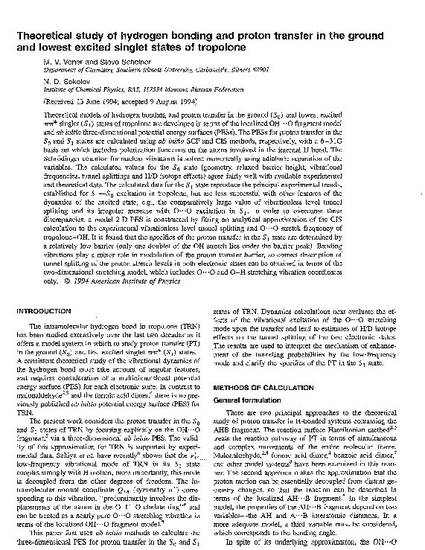
Theoretical models of hydrogen bonding and proton transfer in the ground (S0) and lowest excited ππ∗ singlet (S1) states of tropolone are developed in terms of the localized OH...O fragment model and ab initio three‐dimensional potential energy surfaces (PESs). The PESs for proton transfer in the S0 and S1 states are calculated using ab initio SCF and CIS methods, respectively, with a 6–31G basis set which includes polarization functions on the atoms involved in the internal H bond. The Schrödinger equation for nuclear vibrations is solved numerically using adiabatic separation of the variables. The calculated values for the S0 state (geometry, relaxed barrier height, vibrational frequencies, tunnel splittings and H/D isotope effects) agree fairly well with available experimental and theoretical data. The calculated data for the S1 state reproduce the principal experimental trends, established for S1←S0 excitation in tropolone, but are less successful with other features of the dynamics of the excited state, e.g., the comparatively large value of vibrationless level tunnel splitting and its irregular increase with O...O excitation in S1. In order to overcome these discrepancies, a model 2‐D PES is constructed by fitting an analytical approximation of the CIS calculation to the experimental vibrationless level tunnel splitting and O...O stretch frequency of tropolone–OH. It is found that the specifics of the proton transfer in the S1 state are determined by a relatively low barrier (only one doublet of the OH stretch lies under the barrier peak). Bending vibrations play a minor role in modulation of the proton transfer barrier, so correct description of tunnel splitting of the proton stretch levels in both electronic states can be obtained in terms of the two‐dimensional stretching model, which includes O...O and O–H stretching vibration coordinates only. © 1994 American Institute of Physics.

Originally published by American Institute of Physics in the Journal of Chemical Physics.
Publisher's PDF can be accessed through the remote link.